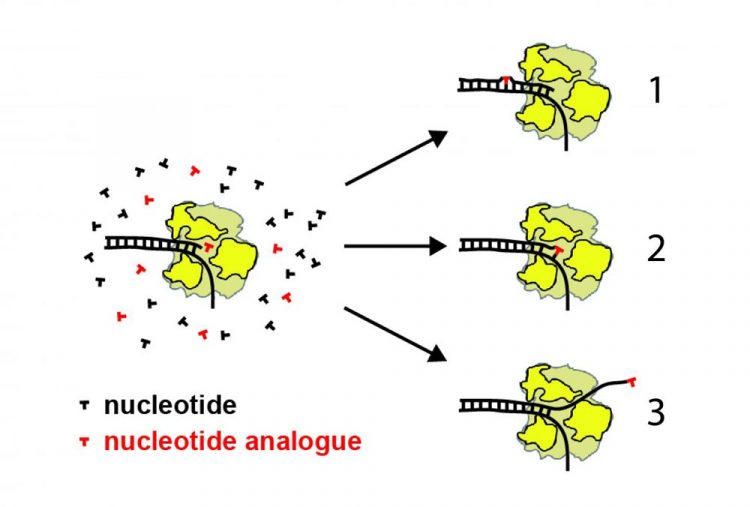Identifying the mechanism for a new class of antiviral drugs could hasten their approval

The mechanism of a new class of antiviral drug. The RNA polymerase enzyme (yellow) replicates the virus genome by incorporating one nucleotide (black) at a time. Nucleotide analogues (red) are designed as antiviral drugs that can disrupt the replication process. The antiviral drugs work by (1) incorporating mutations, (2) stopping the replication process, or (3) a newly discovered mechanism in which the RNA polymerase enzyme pauses and then backtracks. Credit: Penn State
“Viruses are a massive threat to global public health,” said Craig Cameron, professor and holder of the Eberly Family Chair in Biochemistry and Molecular Biology at Penn State and an author of the paper.
“Developing broad-spectrum antiviral drugs — ones that are effective against many different viruses — is vital to our ability to prevent or respond to outbreaks. We were able to demonstrate the mechanism of a newly developed class of antiviral drugs that are potentially broad spectrum.”
Essentially all viruses, whose genomes are composed of RNA rather than DNA, use an enzyme called RNA-dependent RNA polymerase to express genes and replicate their genome in order to make new copies of themselves. The polymerase enzyme is therefore an attractive target for developing broad-spectrum antivirals.
“In order to make more viruses, the RNA polymerase enzyme replicates the virus genome by incorporating nucleotides — the building blocks of RNA or DNA, which are made up of a base and a sugar — one at a time,” said Jamie J. Arnold, an associate research professor at Penn State and another author of the paper.
“For many antiviral drugs, alternative versions of these building blocks are designed such that when they are incorporated during replication, they somehow disrupt the process. To understand the disruption mechanism, we used magnetic tweezers that allowed us to monitor the progression of hundreds of individual RNA polymerase enzymes during the replication process in the presence of antiviral drugs.”
The magnetic tweezers work by tethering one end of hundreds of individual strands of RNA to a surface and attaching a magnetic bead to the other end. A magnet then holds the strands vertically while the researchers monitor the beads under a microscope.
As the RNA polymerase builds new RNA, the length of the strand changes, moving the bead up or down. Because they can monitor hundreds of these processes simultaneously, the researchers are able to build datasets and develop sound statistical backing for their observations.
“We were particularly interested in an antiviral called T-1106,” said Cameron. “It is related to Favipiravir, which was recently approved in Japan for use in the treatment of influenza, but the mechanism was unknown. We were able to show that these antivirals — a new class that alters the base of the RNA building block, rather than the sugar — work in a new way.
Unlike other known antivirals that either incorporate mutations into the replication process or stop it completely, this new class works by causing the RNA polymerase enzyme to pause and backtrack. With this understanding, we can begin to fine tune the design of these antivirals and speed up the process of getting them approved.”
###
In addition to Cameron and Arnold, the research team included Hyung-Suk Oh and Cheri Lee at Penn State; Nynke H. Dekker, Theo van Laar, and Martin Depken at Delft University of Technology; David Dulin of Delft University of Technology and the Friedrich-Alexander University; and Angela L. Perkins and Daniel A. Harki at the University of Minnesota.
The research was supported by the U.S. National Institute of Allergy and Infectious Disease of the National Institutes of Health, the Burroughs Wellcome Fund, the Netherlands Organisation for Scientific Research, and a European Union ERC Consolidator Grant.
Media Contact
All latest news from the category: Life Sciences and Chemistry
Articles and reports from the Life Sciences and chemistry area deal with applied and basic research into modern biology, chemistry and human medicine.
Valuable information can be found on a range of life sciences fields including bacteriology, biochemistry, bionics, bioinformatics, biophysics, biotechnology, genetics, geobotany, human biology, marine biology, microbiology, molecular biology, cellular biology, zoology, bioinorganic chemistry, microchemistry and environmental chemistry.
Newest articles

Zap Energy achieves 37-million-degree temperatures in a compact device
New publication reports record electron temperatures for a small-scale, sheared-flow-stabilized Z-pinch fusion device. In the nine decades since humans first produced fusion reactions, only a few fusion technologies have demonstrated…

Innovative microscopy demystifies metabolism of Alzheimer’s
Researchers at UC San Diego have deployed state-of-the art imaging techniques to discover the metabolism driving Alzheimer’s disease; results suggest new treatment strategies. Alzheimer’s disease causes significant problems with memory,…

A cause of immunodeficiency identified
After stroke and heart attack: Every year, between 250,000 and 300,000 people in Germany suffer from a stroke or heart attack. These patients suffer immune disturbances and are very frequently…





















